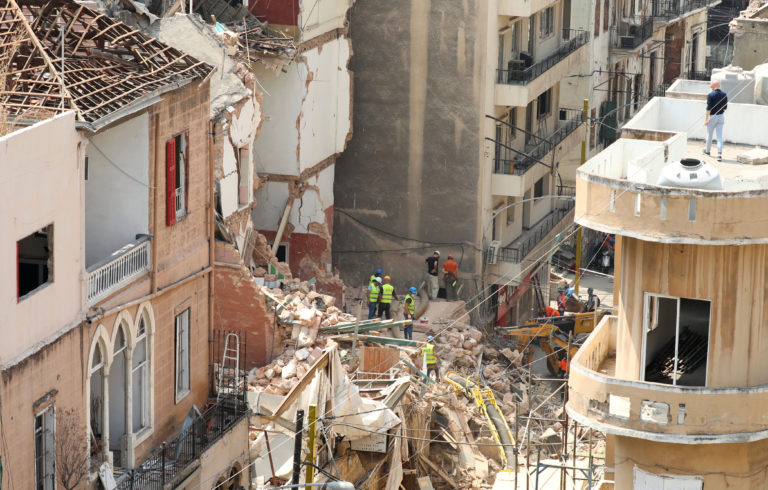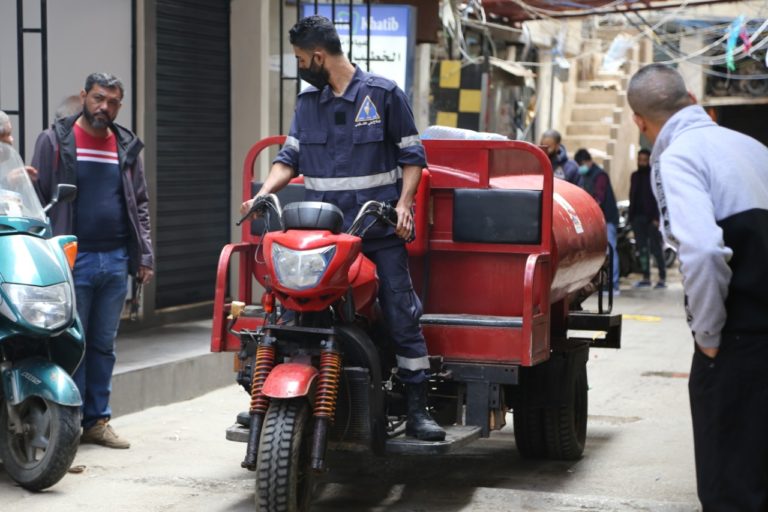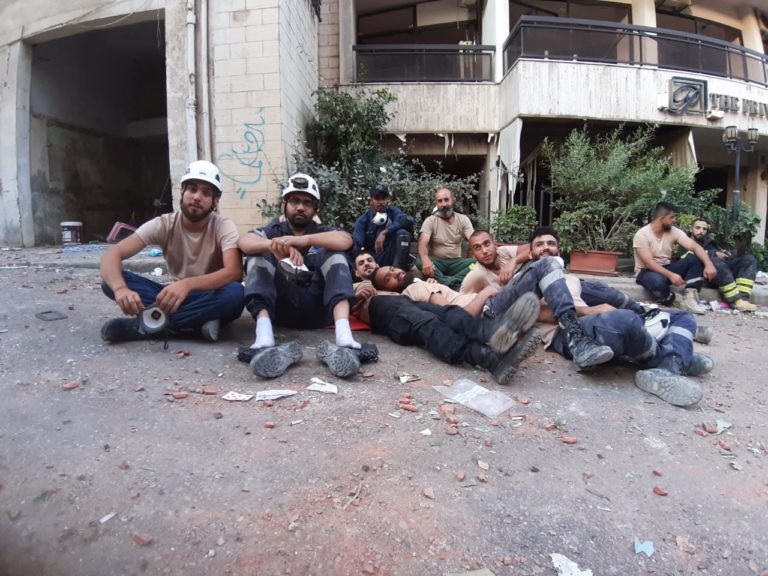The Palestinian Civil Defense was praised for its efforts after the explosion in Beirut. This is the story of how a group of stateless refugees built an organization that saved lives when everything came tumbling down.
On August 4, 2020 Hussein Dimasi was playing with his daughter in the Sabra district of Beirut, when the ground started to shake beneath him. A deafening bang followed. Assuming at first that the city had been struck by an earthquake, he made his way to the roof of his building to get a better view of the scene. That was when he saw a thick pink plume of smoke rising from the port.
Volunteers and a Chilean rescue team dig through the rubble of buildings which collapsed due to the explosion at Beirut’s port, Gemmayze, Beirut, Lebanon. Mohamed Azakir/Reuters
At 6:08 pm local time, the port of Beirut was almost completely wiped out and neighborhoods in a substantial part of the city center were destroyed by a massive explosion. The cause of the blast is believed to be the accidental ignition of 2,700 tons of unsafely stored ammonium nitrate. At least 190 people were killed and over 6,000 were injured.
“I immediately called my colleague who at the time was driving one of our ambulances to have him pick me up. We headed for the explosion site,” Dimasi, whose team of rescuers were among the first responders, relays by phone from Beirut. “As we made our way toward Ashrafieh, [the residential area most severely damaged by the explosion], we started picking up wounded in our car, and taking them to hospitals. We carried dead bodies.”[1]
Over the past few years, Dimasi and his colleagues had trained for disaster scenarios within the Palestinian refugee camps. Now they proceeded to send two additional ambulances and a fire truck to pick up wounded in the city center, while a group of around 50 volunteers began scouting for vacant hospital beds in the area. Some of the injured were taken to the Haifa hospital operated by the Palestinian Red Crescent Society in the Burj al-Barajna refugee camp. Most notably, Dimasi’s team included a unit trained to deal with structural collapse. For two people trapped in a collapsed residential building in Beirut, this expertise would prove to be a matter of life or death in the hours to come.
The Palestinian Civil Defense
Unlike its namesake in the West Bank, the Palestinian Civil Defense in Lebanon (PCDL) is not affiliated with the Palestinian Authority or its security forces. Rather, it began as a donor-driven project spearheaded by the ARK Group, an international non-governmental organization (NGO) that specializes in capacity building in conflict areas, in cooperation with a number of young Palestinians from a closely linked local organization called Ahlam Lajea in early 2014.
At the time, the international community’s humanitarian response to the Syrian refugee crisis and its impact on Lebanon provided refugee youth with ample opportunities to seek funding for projects intended to strengthen civil society organizations in the Palestinian camps and other vulnerable areas.[2] The PCDL, which is today supported by Britain and other international donors, remains the most ambitious of these efforts. According to its founders, the project not only fills an important gap by offering disaster relief in areas abandoned by the state, it is also intended to provide an alternative model to the culture of rampant factionalism, which is so prevalent in the Palestinian communities of Lebanon.
The country’s 12 present-day Palestinian refugee camps famously became the primary base for the Palestine Liberation Organization (PLO) and its armed struggle against Israel from 1969 to 1982. Many Palestinian factions, however, made substantial efforts to widen their presence within these spaces at the turn of the millennium, coinciding with the failure of the peace process with Israel. To date, the camps remain self-governed by a range of armed groups and political leaderships that compete relentlessly for hegemony and territorial control, such as the PLO and the Hamas-led Alliance of Palestinian Forces. The country’s largest and often most turbulent camp, Ain al-Hilweh, which hosts the most substantial division of the PCDL, additionally features two rival Islamist leaderships: the Islamic Forces and the jihadi-inspired Young Muslim Men. Local sources say that each party—although particularly those affiliated with the PLO’s Palestinian embassy in Beirut—go to great lengths to co-opt and infiltrate local NGOs, trade unions and other initiatives in order to strengthen networks of patronage vis-à-vis political opponents. Needless to say, there is a dire need for robust non-factional structures able to endure the volatile political economy of the camps.

A member of the PCDL’s firefighting division rides a motorcycle fitted with a water tank. Photo courtesy of PCDL.
To this end, the PCDL offers a glimmer of hope. What originally started as an endeavor to provide vocational training for troubled camp youth, has in six years grown into a $500,000 a year project. “Currently, we have around 350 volunteers and a few trainers who specialize in firefighting, first aid and search and rescue,” Nizar El Laz says.[3] As a coordinator who has been with the project from the beginning, El Laz explains that the money mostly goes toward maintaining clinics, firetrucks and ambulances, along with motorcycles rebuilt to carry water tanks and fire extinguishers—ideal for missions within the narrow alleyways of the camps.
The focus on search and rescue, he says, emerged after the visit of a Turkish team of rescuers at the outset of the project. This team advised their colleagues to undergo drills in structural collapse due to the unsound architecture of Ain al-Hilweh. In the camp 33,000 inhabitants live crammed together in an area not exceeding 1 square kilometer. Residents have continued to build their apartments on top of each other, layer by layer, in the decades following their expulsion from Palestine in 1947–1948. “Many of the ground floors in the camps are over fifty years old, and were constructed poorly to begin with,” El Laz continues. “You might call it a miracle that none of the buildings have collapsed yet. We consider [this training] an investment for the future.”
On the day of the Beirut explosion, PCDL leader Dimasi dispatched the rescue units based in Ain al-Hilweh and another southern refugee camp to the capital after his colleagues were able to identify voices coming from a destroyed building. Before they could make contact, however, they were stopped by Lebanese security personnel who had grown suspicious of their presence.
Overcoming a Hostile Bureaucracy
Following the Beirut blast, rights organizations condemned Lebanese security forces for being virtually absent from the disaster relief and for instead violently cracking down on hundreds of civilians who—still traumatized and reeling from loss—took to the streets to demand accountability.[4] The emergency response was largely left in the hands of civilian volunteers and international organizations.
Vilified and dispossessed, Lebanon’s refugee populations, be they Syrians or Palestinians, have continuously faced accusations of constituting a fifth column or being the willing pawns of unnamed Sunni Muslim demagogues presumably hungering to tip the country’s demographic balance in their favor.[5] Such scare tactics often aim to stoke fear among supporters of the present-day Lebanese sectarian power-sharing model, which gives a slight advantage to the Christian Maronites in terms of parliament seats and political offices. In reality, no political party—let alone the most vocal supporters of the Palestinian national cause—has done much to challenge a discriminatory system that leaves the roughly 200,000 Palestinians currently residing in the country without rights, marginalized and relegated to their separate spheres. It would be an understatement to say that any cooperation between Lebanese and Palestinian institutions is a rare occurrence.
Frustrated with the cold reception, Hussein Dimasi began making calls to members of Lebanon’s own Civil Defense divisions, who he says he befriended while fighting a series of wildfires that engulfed the country in the summer of 2019. In the end, an army officer intervened on behalf of the PCDL. A line of contact was established with the state’s General Directorate of General Security which, after much deliberation, put Dimasi in charge of the rescue mission, partly due to the Lebanese emergency teams’ lack of equipment.
After security forces finally granted the PCDL access to the building, they were able to locate a Lebanese national named Issam, who was stuck in a narrow opening three stories underneath the ruins of his former home. While digging, they also identified the voice of Ellen, an Ethiopian woman confined in the upper parts of the structure.
Whereas Ellen was rescued after three hours and transported to a nearby hospital, freeing Issam was a far more complex operation—he was further down with his leg caught under a large object. One reckless move could cause what was left of the building to crumble on top of him. The mission carried on into the morning hours, as the rescuers gave him oxygen and chatted with him to keep his spirits up. Curiously, they learned that Issam hails from Darb al-Sim, a Christian majority village that connects to the eastern parts of the Ain al-Hilweh camp. Underneath the rubble, an unlikely meeting between neighbors took place.
On the Brink of Collapse
There is no good time for a disaster, yet the explosion in Beirut came at a particularly bad moment. With COVID-19 infections on the rise, hospitals were already struggling to cope, and the state was facing economic collapse due to years of widespread top-level corruption and financial mismanagement. Last year, banks responded to a growing liquidity crisis by restricting withdrawals of US dollars and by closing their doors for weeks, which caused the value of the Lebanese pound to plummet on the black market and people’s savings to disappear before their eyes.
Interestingly, relief organizations report that Palestinian refugees are at the moment faring better, if only barely, than Lebanon’s poor. “In the camps, not that much has changed,” Qassem Saad says, speaking from his office in the southern city of Sidon.[6] He is the director of Development Action Without Borders, an organization working with Palestinian and Lebanese communities. “We know that 70 percent [of the camp populations] are without jobs, but this is due to underemployment rather than unemployment,” Saad continues, noting that Palestinian refugees have long faced difficulties entering the Lebanese job market due to discriminatory policies. “But they do benefit from established systems of relief,” he says before taking a minute to count food packages his organization has been tasked with distributing to 68 people who recently tested positive for COVID-19 in the nearby Ain al-Hilweh camp. Most Lebanese are not as lucky. “What about Akkar, what about Beqaa?” Saad asks, referring to the ever-expanding poverty belts in the northern and eastern parts of Lebanon.
Managing relief in times of economic collapse is an extremely complicated task. In May, the United Nation’s Relief and Works Agency for Palestinian refugees (UNRWA) was heavily criticized for its COVID-19 relief response in Lebanon. The local banking service handling the cash handouts was found to be imposing ad-hoc fees and dealing in improvised exchange rates, which caused enraged camp dwellers to gather in large dense groups outside of its various branches.[7]
The people behind the PCDL say they also have suffered cutbacks, mainly due to issues of funding. In fact, when the Palestinian rescuers embarked on their mission in Beirut, most of them had gone unpaid for two months.
Out of the Rubble
Issam was carried out of the rubble in Beirut’s Ashrafieh district after 11 hours of rescue work. He survived, but his brother, who was in the same building at the time of the explosion, did not.

Members of the PCDL on a hard-earned break in the Ashrafiyye district of Beirut. Photo courtesy of PCDL.
After the explosion, members of the PCDL were, for a brief moment, celebrated as heroes in Lebanon. They were asked to recount their rescue mission during an emotional prime time interview on the Jadeed TV channel and were invited to the burial of Issam’s brother, where they were praised warmly by the Maronite Bishop of Sidon’s St. Elias Cathedral. “Perhaps what took place was a coincidence, or maybe it was God’s will [to show us] that neighbors can love each other during difficult circumstances,” Bishop Maroun al-Ammar said during the sermon.[8]
Humbled by the attention, Hussein Dimasi says he is proud of what his team has been able to build in the Palestinian camps, but also in terms of strengthening the ties to Lebanese civilian institutions. Yet, he regrets what he calls “racist decisions” that have prevented the PCDL from further engaging in the disaster relief in Beirut. He has no illusions about the challenges ahead, for the Lebanese people and for the stateless refugees, stating that any structural change can only happen at the political level. National political change, of course, is a tall order. At a time when the economy is in tatters, when domestic tensions are on the rise and when the political class seems resilient only in the face of reform, one can only hope that these encounters between neighbors will continue to foster solidarity in the days to come.
[Erling Lorentzen Sogge is a postdoctoral fellow at the University of Oslo.]
Endnotes
[1] Interview with the author, August 24, 2020.
[2] I provide a detailed analysis of these dynamics in my book The Palestinian National Movement in Lebanon: A Political History of the ʿAyn al-Hilwe Camp (London: I.B. Tauris, forthcoming in 2021).
[3] Interview with the author, August 24, 2020.
[4] Tim Hume, “‘It’s Mind-Boggling’: Lebanese Security Forces Condemned for Firing Tear Gas,” Vice, August 7, 2020.
[5] “[Former Minister of Foreign Affairs, Gebran] Bassil: Those who Accuse us of Racism Against the Displaced are Conspirators and Benefactors,” al-Markazia, June 15, 2019. (Arabic)
[6] Interview with the author, August 21, 2020.
[7]“Some Branches of ‘Bob Finance’ Withold Sums of Aid Money, and Complaints Continue for the Second Day,” Palestinian Refugees Portal, May 19, 2020. (Arabic)
[8] Video of the sermon shown to the author.
